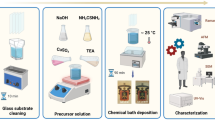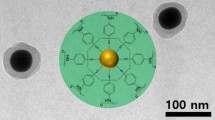Abstract
This work reports the growth of layered nickel hydroxide/gold films by sol-gel and dip-coating methods to obtain colored films for applications in switchable optical devices. The nickel and gold-based films were deposited on mica and glass plates from alcoholic sols. The distribution of electron density inhomogeneities (voids, nickel and gold particles) in the films was determined by means of small angle X-ray scattering (SAXS). The SAXS measurements were used to determine the nickel and gold particle sizes and to give guidelines to the appropriate chemical route to deposit homogeneous colored films. X-ray diffraction (XRD) was used to monitor the crystalline properties. Transmission electron microscopy (TEM) was used to observe the nanostructure of the gold particles and atomic force microscopy (AFM) to analyze the film surface. Spectral transmission was used to investigate the optical properties in these different layered systems, which present an absorption band in the visible region due to the gold aggregates. The composite material is deep blue. The analyses of SAXS data, TEM and AFM pictures are consistent, i.e., the formed Au particles are polydisperse in size and their clustering depends on the NiO x H y layer. The Au particles are polycrystalline, with [111]-preferred orientation, as determined by XRD. The nickel oxy-hydroxide matrix is amorphous.
Similar content being viewed by others
References
J.D. Joannopoulos, P.R. Villeneuve, and S. Fan, Nature 386, 143 (1997).
E.K. Sichel, J.I. Gittleman, and J. Zelez, Appl. Phys. Lett. 31, 109 (1977).
T. He, Y. Ma, Y. Cao, W. Yang, and J. Yao, J. Electrochem. Soc. 514, 129 (2001).
T. He, Y. Ma, Y. Cao, Y. Yin, W. Yang, and J. Yao, Appl. Surf. Sci. 180, 336 (2001).
K. Nagase, Y. Simizu, N. Miura, and N. Yamazoe, Appl. Phys. Lett. 64, 1059 (1994).
C.G. Granqvist, Handbook of Inorganic Electrochromic Materials (Elsevier Science, Amsterdam, 1995), p. 201.
P.M.S. Monk, R.J. Mortimer, and D.R. Rosseinsky, Electrochromism: Fundamentals and Applications (VCH. Elsevier Science, Weinheim, 1995), p. 10.
S.K. Deb, Sol. Energy Mater. Sol. Cells C25, 327 (1992).
C.M. Lampert, Solar Energy Mater 11, 1 (1984).
A. Donnadieu, Mater. Sci. Engg. B-Solid 3, 185 (1989).
F.F. Ferreira, M.C.A. Fantini, and A. Gorenstein, Solid State Ionics, in press.
M. Ando, T. Kobayashi, and M. Haruta, Sensor Actuators BChem. 32, 157 (1996).
I. Hotovy, J. Huran, P. Siciliano, S. Capone, L. Spiess, and V. Rehacek, Sensor Actuators B-Chem. 78, 126 (2001).
M. Epifani, E. Carlino, C. Blasi, C. Giannini, L. Tapter, and L. Vasanelli, Chem. Mat. 13, 1533 (2001).
F.F. Ferreira, M.H. Tabacniks, M.C.A. Fantini, I.C. Faria, and A. Gorenstein, Solid State Ionics 86-88, 971 (1996).
L.R. Doolittle, Nucl. Instrum. Meth. B. 9, 344 (1985).
D.I. Svergun, J. Appl. Cryst. 24, 485 (1991).
A. Guinier and G. Fournet, Small-Angle Scattering of X-Rays (Wiley, New York, 1955), p. 1.
Author information
Authors and Affiliations
Rights and permissions
About this article
Cite this article
Haddad, P., Ferreira, F., Brito, G. et al. Gold-Nickel Hydroxide Multi-Layers with Selective Absorption in the Visible Range. Journal of Sol-Gel Science and Technology 30, 179–185 (2004). https://doi.org/10.1023/B:JSST.0000039503.67720.2c
Issue Date:
DOI: https://doi.org/10.1023/B:JSST.0000039503.67720.2c




